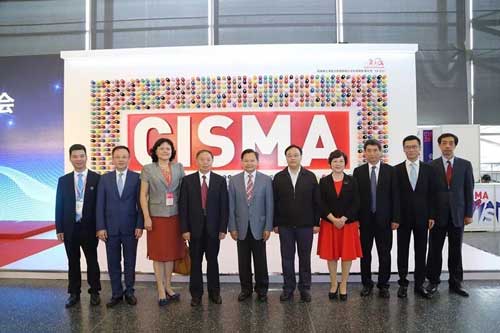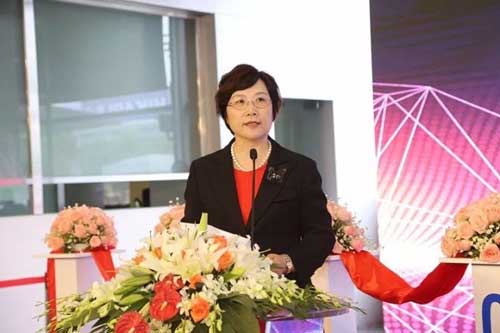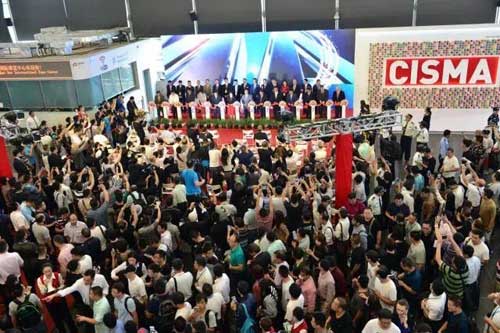FW
Powermax, a high-end smart technology products producer and Mianyang Weibo Electronic Co., Ltd. signed officially strategic cooperation agreement during the opening day of CISMA 2017, opening a new chapter in the sewing machinery industry.

The signing ceremony was held in presence of He Ye ( Director of China National Sewing Machinery Association), Yang Xiaojing (Vice Director of China National Sewing Machinery Association), Chen Ji (General Secretary of China National Sewing Machinery Association) and Liu Yong (Chief of Automation Research Institute of China Weapon Equipment Group) .

He Ye affirmed the achievements of Powermax and Weibo, she pointed out that Powermax and Weibo are "vanguard of industrial enterprises" in the field of sewing machinery industry units, they are the leading suppliers of sewing equipment series . “While contributing to the technology innovation, Powermax also set off a new revolution on global customer service . In three years, the company has established 1000 technical service centers, trained 1000 people as qualified maintenance personnel.” She added.

Powermax also signed authorization agreement on the spot with 10 foreign technology centers and 20 domestic technology centers including MAHALA、Sokkar For Sewing Machines、KO.VIWAT、 Welttec、 Sun Special、Sheng Da Electronic Technique Co., Ltd、 Myanmar Jie Yao Trading CO., LTD 、Hong Phi Export & Import CO., LTD、United Machineries、KECOGLU MAKINA SAN.VE, TIC.A.S、 and others, enabling the company to cover more than 10 countries, and have more than 200 domestic technical centers.
UL is the latest company to join the Sustainable Apparel Coalition (SAC). It will use the group's sustainability measurement tool, the Higg Index, to drive environmental and social responsibility throughout its supply chain. The Higg Index is an open sourced, indicator-based tool that allows suppliers, manufacturers, brands and retailers to evaluate materials, products, facilities and processes based on environmental and product design choices.
In its relationship with the SAC, UL will contribute both data and resources to support the Higg Index, which measures sustainability performance and drives supply chain transparency and decision-making to better efficiency and sustainability impact.
UL partners with clients to support them with every aspect of sustainability and supply chain management, including developing a proactive stance and demonstrating green and sustainable credentials, assisting in gaining better visibility into supply chain issues and mitigating risk and implementing customized and comprehensive environmental management systems.
UL helps companies demonstrate willingness to invest in the long-term future of the business through sustainable supply chain practices and assists them in gaining a competitive advantage through sustainability initiatives and implementation of best practice procedures.
Indian textile and apparel industry members of SAC include the Aditya Birla Group, Eastman Exports Global Clothing, Pratibha Syntex, Arvind and KG Denim.
CISMA 2017 opened yesterday here in Shanghai on Sept. 26, 2017 at Shanghai New International Expo Center, among the large gathering of Chinese government officials, including Zhang Chonghe (Chairman of China Light Industry Association) , He Ye (Chairman of Chinese Sewing Machinery Association) , Chen Dapeng (vice president of China Textile Industry Association and chief vice president of Chinese Garment Association), presence of global sewing machiery association leaders from Japan, Germany and the United States, and industry representatives. More than 100 people attended the opening ceremony.

HeYe, Chairman of China Sewing Machinery Association, summed up the achievements gained by sewing machinery industry in the digital, intelligent technology innovation and application marking the beginning of this new round of industrial revolution. She pointed out that the CISMA2017 improves and enhances the comprehensive system of internationalization、specialization、and information of trade, information and communication ,thus boost the technology communication and industry linkage very much.

She assured CISMA will expand service, create value with the open mind like “all rivers run into sea”. “In the new journey of the ‘The Belt and Road Initiative’, under the guidance of the spirit of the Silk Road, CISMA expects to reach win-win co-operation in smart sewing” she summed it up.

CISMA 2017, that opened today is showcasing the most advanced equipment and technical achievements of the industry in twelve exhibition halls. More than 1200 exhibitors from 24 countries and regions are going to meet face-to face and carry out communication and demand pairing with more than 50,000 professionals from more than 100 countries and regions through multiple media such as offline, online etc.

Two years ago, CISMA came up with the idea of revolutionary theme of Intelligent Sewing Solutions. It ushered in a new round of global sewing machinery technology and industry transformation. And now, two years later CISMA 2017 continued to focus on intelligent sewing machinery developments.
This edition of CISMA has further strengthened the organization of customers from overseas and the downstream industry. Professionals and garment associations from Pakistan, India, Sri Lanka and China, China Home Textile Industry Association, China Industrial Textiles Association, China Leather Industry Association, China Furniture Association, and other institutions and trade associations are expected to attend CISMA 2017.

Intelligent technology- a new industrial revolution
Since the launch of a new industrial revolution, the sewing machinery industry has become the global focus, becoming a model of digital, intelligent technology innovations and applications in many fields. The industry, whether in the unmanned manufacture of parts and components, or in the development of smart sewing equipment and sewing production lines, has made remarkable achievements in integrating multiple industrial platforms, while at the same integrating consulting, designing, manufacturing, warehousing and service in a single body and covering the related upstream and downstream industrial sectors.

The humanized smart sewing factory is also being transformed from a mere idea into a substantial, sensible and usable reality, which is widely used in the downstream fields of clothing, home textiles and leather.
In China, transformation and upgradation of the industry have been carried out effectively. The industry has developed vigorously and its status has improved significantly. The sewing machinery industry has become a typical equipment of intelligent manufacturing in light industry. Multiple product and projects are included in the national smart manufacturing pilot projects. The industry is rapidly changing from simple daily and industrial machinery manufacturing to overall solutions and value-added services.
A river in China has turned blue, an indigo blue, all from the pollution of making blue jeans. In Bangladesh, tannery workers with no protective clothing treat leather with noxious chemicals, before dumping the runoff into the river. Further downstream, people bathe in the same waters that are deep black, orange, purple. Children in these areas are not able to smell and skin diseases – rashes, ulcers, boils – are widespread. Pollution, often carcinogenic, enters the food chain too: boatmen bring a haul of fish to shore, which they find floating on the surface of the black water, dead.
This is a systemic problem, driven in part by consumer demand for cheap clothing in wealthier countries. The developed world embraced free trade in the 1980s and 90s, resulting in the closure of the biggest textile factories in America and Europe, previously the hubs of global production regulated by strict pollution laws. The textile and leather industries were just two of many pollution-heavy industries that shifted across the planet towards the end of the twentieth century.
In pursuit of lower priced goods, higher profit margins from cheap labor, and nonexistent regulations, factories sprang up in China, India, Bangladesh and Indonesia. Simultaneously, demand, production and pollution ballooned as the west embraced the hedonistic rush of no-strings-attached cheap clothing.
As advances in technology and changing trade patterns affect opportunities for export-led manufacturing, innovations like smart automation, advanced robotics and 3-D printing are increasingly influencing which locations are attractive for production, says a World Bank Report. While these shifts threaten significant disruptions in future employment, particularly for low-skilled workers, they also offer opportunities.
Technology and globalization are changing how manufacturing contributes to development. In the past, the manufacturing sector created jobs for unskilled workers and increased productivity. In the future, developing countries will need to update their policies along with their infrastructure, firm capabilities and job creation strategies to meet the demands of a more technologically advanced world.
Changing technologies and shifting globalization patterns are destined to reshape manufacturing-led development strategies. Global value chains remain concentrated among a relatively small number of countries, and smart automation, advanced robotics, 3-D printing and other advances being incorporated by global manufacturers of apparel, cars, electronics, consumer and other goods are shifting how countries and firms compete for production.
While manufacturers of apparel and leather goods have traditionally sourced production in countries with low labor costs, greater demands for customization opens up the possibility of 3-D printed goods, which are design-intensive, typically produced in small batches on short cycles, and require proximity to consumer markets.
Khurram Anwar Khawaja is the new chairman of Pakistan Hosiery Manufacturers Association (PHMA). Shahid Rafi and Naeem Ahmed are senior vice chairman and zonal chairman.
Khawaja expressed his resolve to meet the challenges of the times and to give a boost to the export sector by adopting diversified marketing techniques and giving practical support to the industry. He will continue with his efforts for the promotion and protection of value-added textile industry. His top priority would be uninterrupted energy supply to the knitwear sector, resolution of tax related issues, and a favorable environment for the promotion of hosiery industry in Pakistan, especially in Punjab.
The outgoing chairman and vice chairman highlighted the achievements made during 2016-17 and expressed the hope that the new team headed by Khurram would continue the excellent work in the best interests of hosiery manufacturers. There are about 13,372 circular knitting machines, 10,646 flat knitting and 23,241 socks knitting machines in the country. Capacity utilization is around 70 per cent.
Pakistan’s value added textiles in general and the apparel export sector in particular are under severe pressure due to hard competition in the international market being faced from competing countries like Bangladesh, Vietnam and Cambodia.
Invista has deployed a new technology for nylon to substantially improve the production process. The new technology is Invista’s adiponitrile or ADN technology.
ADN is used for the hydrocyanation of butadiene using a homogeneous nickel catalyst. ADN is a critical intermediate in the production of hexamethylene diamine, which is reacted with adipic acid to produce nylon 6,6. The update extends the company’s ADN technology in several aspects, including improved product yields, reduced energy consumption, lower greenhouse gas emissions, enhanced process stability and reduced capital intensity, compared to existing technologies.
As the preferred supplier for ADN, Invista supports growth and innovation in the nylon industry by continually investing in research and development, including the continued improvement of its ADN technology. The new ADN technology is the result of more than 40 million dollars in research and development spanning four years on two continents. These investments highlight Invista’s dedication to the nylon 6,6 industry and positions Invista and its customers with an advantaged and sustainable value chain.
With brands like Lycra, Coolmax, Cordura, Stainmaster and Antron, Invista is one of the world’s largest integrated producers of chemical intermediates, polymers and fibers. The company’s advantaged technologies for nylon, spandex and polyester are used to produce such products as clothing, carpets and air bags.
Pakistan’s August textile exports rose nine per cent year-on-year. Similarly, July textile exports picked up 16 per cent as compared to July 2016. So far for the second quarter of financial year ’18 there has seen a six per cent increase as compared to the corresponding period in previous year.
There was a boost in the value-added segments including readymade garments, knitwear, towels and bed wear. The highest growth was witnessed in knitwear at 21 per cent whereas bed wear and towels grew by 15 per cent and 12 per cent on a year-on-year basis.
However, yarn exports were down by 13 per cent, while cotton cloth exports dipped by eight per cent year-on-year. Falling cotton prices as well as slowing demand in neighboring China have resulted in lower volume as well as value growth.
There are a host of challenges confronting the textile sector. The cost of inputs used in higher value added segments such as readymade garments and knitwear is high. The rising cost of doing business has clawed away at Pakistan’s global cost competitiveness. An overvalued currency has aggravated matters further. When compared with regional competitors such as Bangladesh, Vietnam, India and China, the country’s electricity and gas tariffs are almost 30 per cent higher.
Many new Nepali designers have joined the garment business of late. Due to a competitive advantage, they enjoy owing to lower production costs at home, their business prospects are good and they are gradually expanding to overseas markets. They often receive orders from Nepalis living abroad and supply to countries like Hong Kong, United Kingdom, United States, Australia, Singapore, and Japan.
The clientele that orders designer clothes ranges from celebrities to regular customers who would love to flaunt their clothes at events, parties and other occasions. While a single costume of international designers could cost from 1000 to 1500 dollars, clothes of Nepali designers are available at much lower prices. Considering its prospects, many students are now studying and entering the field of fashion designing.
At the moment party dresses like lehangas and saris are trending. However, there is no textile company in Nepal that produces the exclusive fabrics that designers need. Nepali textile companies produce only dhaka and cotton fabrics, which is why designers have to import fabrics from other countries. They are focusing on mass production with marginal profit, keeping a long-term vision for sustainable business growth. The profit margin fluctuates most of the time.











